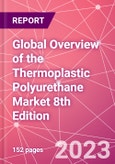This report contains the most up-to-date information available on Thermoplastic Polyurethanes in this market study. This comprehensive review builds upon previous editions of the publication.
It covers TPU production & consumption data for the year 2022 and provides anticipated figures for 2027.
The report covers the following TPU market sectors:
Technologies:
Data presented is for both production & consumption of TPU:
- Injection
- Extrusion
- Adhesives
- Coatings
End-Use Sectors:
Data presented is for the consumption of TPU only:
- Automotive
- Construction
- Engineering
- Footwear
- Hose & Tubing
- Medical
- Wire & Cable
The geographical scope is as follows:
Europe, Middle East & Africa
Western Europe:
Austria, Benelux, France, Germany, Italy, Nordic, Portugal, Spain, Switzerland, UK/Ireland
Central & Eastern Europe:
Czech Republic, Hungary, Poland, Russia, Slovak Republic, Turkey
Africa/Middle East:
Egypt, Iran, Maghreb, South Africa, Rest of Middle East
The Americas
North America:
USA, Canada
South America:
Argentina, Brazil, Mexico, Other Central & South America
Asia-Pacific
Australia, China, India, Indonesia, Japan, New Zealand, Philippines, Malaysia, Singapore, South Korea, Taiwan, Thailand, Vietnam, Rest of APAC
Table of Contents
Samples

LOADING...
Executive Summary
This study examines the national, regional, and global markets for thermoplastic polyurethanes for 2022 and builds up on the research from previous editions. It explores the market trends driving TPU production and subsequent demand, provides an indication of raw material consumption, and presents future growth opportunities in the TPU market. Five-year market forecasts to 2027 are also included.
The total production of TPU was 935,000 tonnes in 2022. The current economic and political issues caused production to contract by 3.4%. Globally, the market is expected to show moderate growth in 2023, which is mainly caused by the recovery of production in China. The production of adhesive grades declined by 4.2% while the production of coatings grades only contracted by 1.9%.
The TPU market has not been as severely affected by the economic crisis compared to other segments within the polyurethane industry.
Asia Pacific remains by far the biggest TPU producer globally, with 72.6% of global production taking place in this region. Western Europe remains the second largest producing region, followed by North America. The production in other regions remains limited.
The market segment for TPU converters is highly fragmented, consisting of a high number of small and medium-sized companies that manufacture custom made products for a huge variety of end-use applications. Many of these companies source their raw materials through PU systems houses and various distributors, which makes it particularly challenging to accurately estimate the total product output and raw material demand, even though the majority of raw materials are manufactured by a limited number of companies.
The consumption of TPU also decreased by 5.6% globally in 2022. The Eastern European market was most affected due to the war in Ukraine. Consumption also decreased considerably in APAC because of other economic factors.
There is still room for growth of TPU usage in the automotive sector, especially with the increasing demand in the electric vehicle segment, including tubing and interior parts, as well as complex materials under the bonnet. There is also potential for complex 3D printed parts for the automotive industry. The automotive industry is conservative and TPU is not expected to gain market shares from existing materials in standard vehicles, especially in the wire and cable market. However, new plants and production processes for electric vehicles could offer a chance to gain market share from more established materials.
Sustainability and the circular environment continue to get a lot of attention, and these have become a key topic for many producers globally. It is expected that sustainability, renewable materials, and the circular economy will become the key drivers in the next ten years. TPU could profit from the reduction of single-use plastics, especially in the food and beverages industry.
The future growth of TPU is highly dependent on innovation. According to industry experts, investment in research and development will be key to strengthening the companies’ positioning. Many converters are also expanding their product portfolio and more specialised grades are needed to offer highly specialised solutions. 3D printing is starting to gain market share, but grades for these applications are still niche and 3D printing companies still use extrusion grades because of a lack of materials on the market. It is reported that all large producers offer grades for 3D printing applications already.
The 3D printing technology could benefit smaller companies with limited financial capabilities in the future, because of the low initial investment compared to the production of conventional TPU parts. The market for complex parts for niche applications is especially of interest for this manufacturing process. This would enable companies to adapt quickly to the high demand generated by customer expectations.
Companies Mentioned (Partial List)
A selection of companies mentioned in this report includes, but is not limited to:
- BASF Polyurethanes GmbH
- COIM
- Covestro AG
- Huntsman Polyurethanes
- The Lubrizol Corporation
- Wanhua Chemical Group Co. Ltd.
Methodology
Information provided in these reports are based on existing in-house data and an extensive programme of interviews with leading product manufacturers, trade associations, distributors and raw materials producers involved with the specific market researched. These interviews are conducted within the 3-6 months leading up to the publication of the study, with the duration of the research programme and the number of interviews completed depending on the scope of the study. The analyst publishes both regional and global reports, and in most cases, the interviews are conducted in the native language of the individual respondents.
In addition, published data and statistics are also reviewed in order to produce as accurate figures as possible for size of markets studied. Market forecasts are based upon industry and economic forecasts as well as upon other relevant commercial and technical issues likely to affect individual market sectors and products, as well as the interviews conducted for the study.

LOADING...










